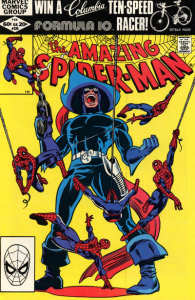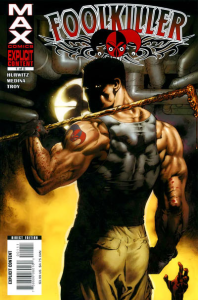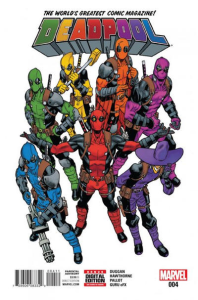As I explained last week, this month is all about vigilantes operating outside of Gotham City. Last July, I addressed obvious series about street justice like The Punisher and Vigilante, but this time around I’m focusing on more off-kilter comics.
Well, they don’t come much more off-kilter than Foolkiller.
Cult favorite writer Steve Gerber first introduced the concept of Foolkiller in 1974, during his trippy run on the horror series The Man-Thing. It started out as one more drop in Gerber’s endless flood of wild ideas – a throwaway villain amusingly riffing on the era’s trend of reactionary vigilante fiction.
In ‘Day of the Killer, Night of the Fool!’ and ‘The Making of a Madman!’ we met a religious crusader who felt compelled by the Lord to drive around in a red convertible and incinerate anyone he considered a ‘fool’ with his weird ray gun. Artists Val Mayerick and Jack Abel illustrated his epic entrance:
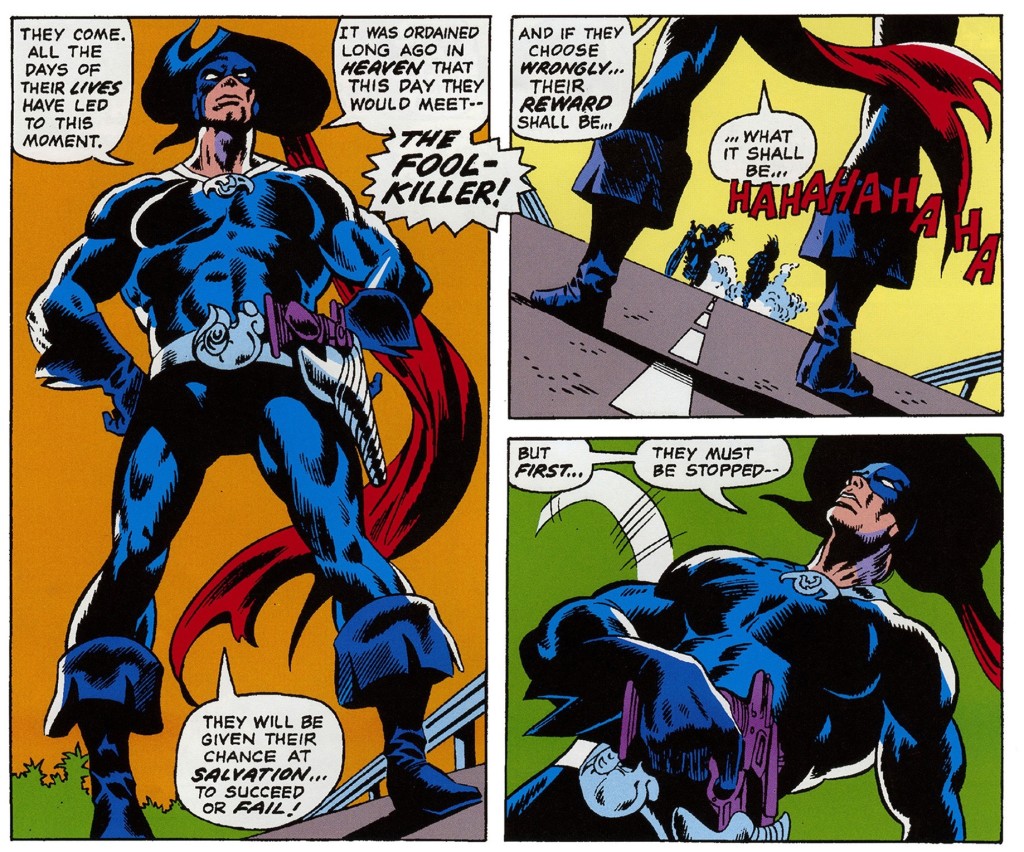 The Man-Thing #3
The Man-Thing #3
Typically, Gerber soon adorned the character with all sorts of outlandish touches. The Foolkiller – later identified as Ross Everbest – was a military enthusiast (he idolized his parents, who had died in World War II and Korea) and his secret origin involved going berserk over the hippie protests against the Vietnam War. What’s more, Everbest had been born a cripple and had been healed by the evangelist Reverend Mike Pike, who became his mentor. One day, Everbest found Reverend Mike with a prostitute, so he beat the preacher to death and built him a shrine. He now consulted Mike’s corpse (preserved in formaldehyde) for guidance.
As if this wasn’t idiosyncratic enough, the Foolkiller’s modus operandi involved giving his intended victims a card, allowing them 24 hours to stop being foolish:
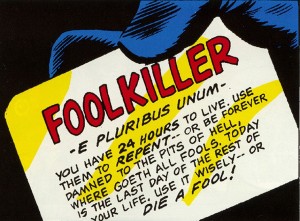 The Man-Thing #3
The Man-Thing #3
After trying to kill the cast of The Man-Thing, this version of the Foolkiller met his end when a blast from his purification pistol shattered Reverend Mike’s tomb and a plexiglas shard pierced his heart. Irony!
Three years later, Steve Gerber briefly revived the concept in the classic superhero series Omega, the Unknown, in which a poet called Greg Salinger tracked down the original Foolkiller’s weapons and costume. Salinger secularized the Foolkiller’s mission, now going after those who didn’t share his poetic sensibilities. It was a delightfully kooky concept, but sadly the series was soon cancelled.
Yet the best was still to come. In 1990/1991, Gerber finally had the chance to fully develop Greg Salinger when he did a brilliant 10-issue Foolkiller comic…

 Foolkiller #2
Foolkiller #2
Like all of Steve Gerber’s greatest works, Foolkiller has an offbeat vibe that defies easy characterization. There are elements of blatant parody and the protagonist’s strange disguises are clearly played for chuckles, but this is spliced with very dark overtones and an earnest engagement with social and existential questions. In a way, this is Gerber’s version of the ‘gritty reboot’ trend taking place in the aftermath of The Dark Knight Returns, with deadly serious takes on even the most ludicrous characters. Or maybe the project started out as a satire of this trend, but Gerber is so good at writing about alienation that he couldn’t help himself (a decade later, he would go on to successfully mix high school angst and prison drama in Hard Time).
I cannot stress enough how unique and captivatingly odd the whole thing feels. To make matters even more ambiguous, J.J. Birch’s moody art – inked by Tony DeZuniga and Vincent Giarrano, colored by Greg Wright – plays it completely straight. The result is compelling as hell!
More than Greg Salinger (who had been committed to a mental institution), the real star of the series was Kurt Gerhardt, an average guy downtrodden by society who was inspired by a televised interview with Salinger into becoming the next Foolkiller. At first, Kurt’s forays into vigilantism only managed to make him even more miserable: he either botched his attacks or spent time agonizing because the media didn’t understand his peculiar mission. Kurt eventually grew into the role, although not before a memorable training montage:
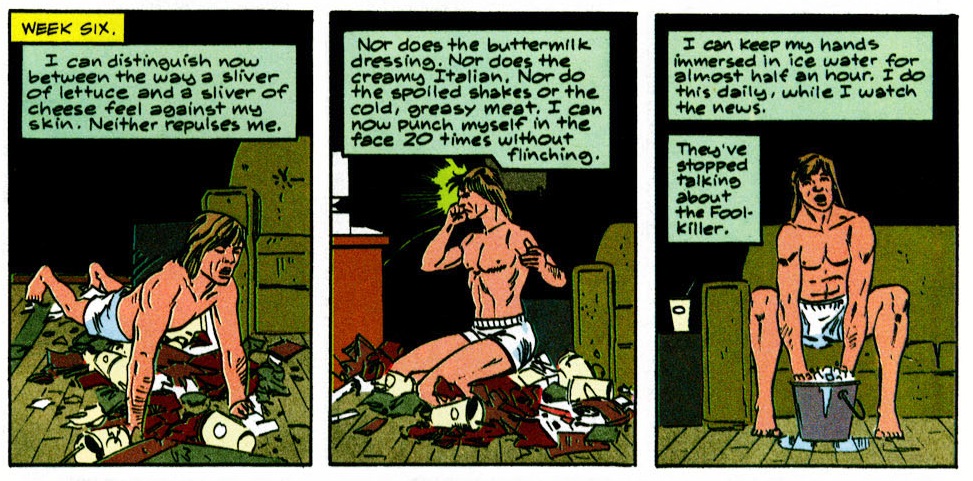 Foolkiller #4
Foolkiller #4
And certainly not before he started donning a freaky S&M mask:
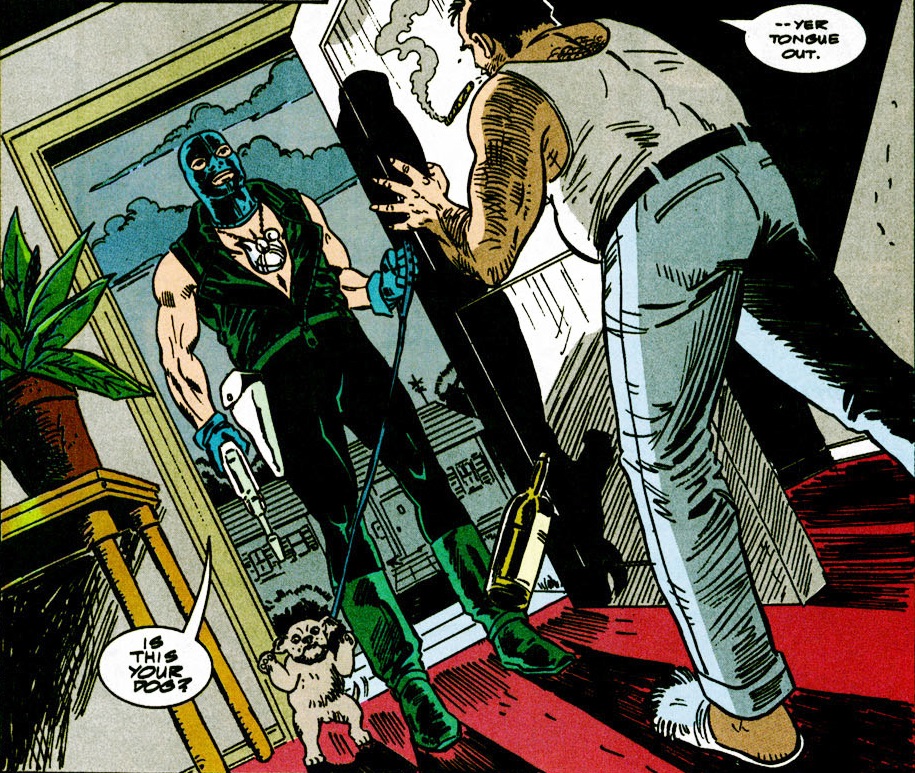 Foolkiller #5
Foolkiller #5
As you can tell from the passages above, especially the war diary, there was more than a wink at the wave of Punisher comics coming out at the time. Indeed, it’s cool that Marvel put out what was in many ways an anti-Punisher series, as Foolkiller took a similar concept yet removed most of the action, preferring to focus on deeper issues and touching slices of life (the scenes where Kurt loses his job and marriage are genuinely heartbreaking… and a whole subplot at the Burger Clown fast food joint creates a relatable, lived-in microcosm).
Not that Gerber’s comic was a straightforward, moralistic rebuttal of vigilante fiction. It didn’t shy away from rubbing our faces in the genre’s primordial appeal (for example, when Kurt took down a wife-beater), but it problematized it in a thoughtful manner, making the most out of the vague and ultimately silly nature of the word ‘fool’. Unlike Frank Castle, who is always resolute and clear-minded about his war on crime, Kurt Gerhardt was in a permanent state of crisis. He gradually realized that most people were fools in one way or another – from drunk drivers to employees of credit card companies – and that, once he accepted the possibility of killing them, it was hard to draw a clear line about who did or did not deserve his punishment… It didn’t help that at one point he was attacked by a child and had to figure out at what age people changed from victims into fools.
And just when you thought things couldn’t get more morally complicated, this happened…
In the wonderfully mystifying ‘42 Days’ (Foolkiller #8), the Foolkiller tries to wrap his head around society’s frustration with the Gulf War. He finds fools on all sides of public debate, vaporizing demonstrators and pundits – and also going after anti-toy activists!
This fed into the series’ momentum towards increasingly uncertain political territory. Not only did Kurt expand his targets from street gangs to Trump-like corporate fat cats, he kept branching out – at one point, he even decided to deal with the issue of political correctness in college campuses. Between all this and the early nineties’ socio-economic concerns, Foolkiller serves both as an interesting time capsule and as a depressingly resonant work in today’s world. In fact, in many ways you can easily make the case that the series was well ahead of the curve, uncannily anticipating the themes of more popular, recent comics.
To be sure, you can make that claim about much of the output of Steve Gerber, who produced some of the most fascinating comics out there. While other creators have told fine stories with the Foolkiller, so far none has taken the concept into such unexpected and challenging directions!



